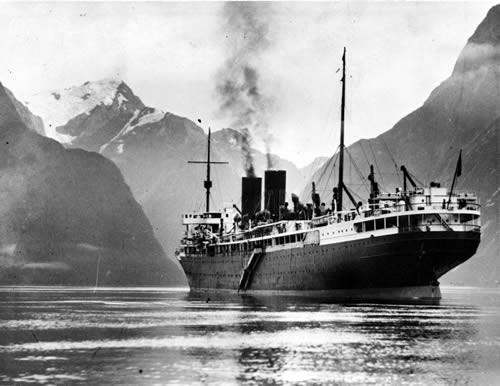
The Monowai photographed in Milford Sound during a summer cruise in 1933.
The Monowai's mission of mercy
New Zealand has a small connection to the poignant story of Anne Frank, via her father, Otto, and the merchant ship TSS Monowai.
On 22 April 1945, shortly before the end of the war in Europe, the Monowai sailed from England for Odessa on the Black Sea carrying 1600 Soviet citizens who had been captured serving with the Germans in France. The ship then embarked Jewish Holocaust survivors from Western Europe - including Otto Frank - who had been liberated from the Auschwitz death camp by the Soviet army. On 21 May it sailed from Odessa for Marseille, arriving on the 27th.
In The Footsteps of Anne Frank (1959), Ernst Schnabel wrote that: 'The Monowai flew the New Zealand flag, and had come all the way from New Zealand so that a few survivors from Europe could return home.' The men slept in hammocks, while the women were accommodated in cabins. Otto was impressed by the ship's comfort, the abundant food and the kindness of its crew.
By this time Otto had discovered that his wife, Edith, had died at Auschwitz, but he knew nothing of the fate of his two daughters, Anne and Margot. On board the Monowai, he wrote to his mother in Switzerland:
My entire hope lies with the children. I cling to the conviction that they are alive and that we’ll be together again, but I’m not promising myself anything.
In July, back in Amsterdam, he learned the devastating news that both girls had died of typhus in Bergen-Belsen in March 1945, just weeks before the camp’s liberation. Otto lived until 1980, by which time Anne Frank’s remarkable teenage diary had become an icon of 20th century literature.
Wartime service
Best known in peacetime as a trans-Tasman liner, the Union Steam Ship Company's Monowai served throughout the Second World War in various roles.
From 1940 to 1943 the steamer flew the white ensign as an armed auxiliary cruiser with the New Zealand Division of the Royal Navy (from 1941 the Royal New Zealand Navy), manned by a mixture of naval regulars, reservists and merchant seamen. In 1942 HMNZS Monowai fought off an attacking Japanese submarine near Fiji. The following year – with many Kiwi officers, engineers and crew still aboard – the ship reverted to the red ensign, as a troop transport for the British Ministry of War Transport.
Te Puea's gift
Throughout its war service, the Monowai carried on its bridge a model of the legendary Maori canoe Tainui and a ceremonial cloak presented by Waikato leader Te Puea Herangi. Captain G.R. Deverell and his successor, G.B. Morgan, were said to have donned the cloak whenever the ship was in danger of attack.
During the D-Day landings of 6 June 1944 the Monowai served as an assault landing ship, delivering 1800 commandos to Gold Beach. In 1945, after crossing the English Channel 45 times with a total of 73,000 Allied troops on board, it was deployed as a repatriation ship for refugees and former prisoners of war.
After a second voyage to and from Odessa in June 1945, the Monowai shipped Indian troops home from the Middle East. When Japan surrendered in August, it was dispatched to Singapore as a ‘mercy ship’ to repatriate British prisoners. On 13 September the vessel sailed with 650 service personnel and 199 civilians on board, arriving in Liverpool on 8 October.
Numerous other repatriation voyages followed, before the worn-out Monowai was finally handed back to the Union Company in 1946; after a major refit, it returned to the Tasman run in 1949. The veteran ship was withdrawn from service in 1960 and scrapped in Hong Kong.
Further information:
- TSS Monowai, 1925-1960 (NZ Maritime Record)
- Carol Ann Lee, The Hidden Life of Otto Frank, Viking, London, 2002
- Ernst Schnabel, The Footsteps of Anne Frank, Longmans, London, 1959

Community contributions